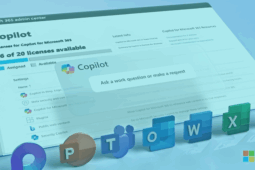
AI in Unified Communications is no longer a future ambition—it’s a current directive. Microsoft Ignite showcased how Copilot is redefining business productivity, and now IT and UC teams are expected to make it work. Companies that integrate AI into their UC stack are already gaining a competitive edge with automated insights, real-time call analytics, and streamlined workflows.
But here’s the problem—most UC environments aren’t built for AI. Legacy PBX systems, fragmented voice data, and compliance gaps will slow down adoption or, worse, create security risks, privacy violations, and operational disruptions.
Leadership wants AI-driven productivity, but IT teams have to solve real implementation challenges:
- How do we ensure AI doesn’t compromise sensitive conversations?
- Can we maintain compliance with HIPAA, GDPR, or PCI-DSS while leveraging AI?
- Will our existing UC platform even support AI without major infrastructure changes?
Without the right preparation, AI will be more of a liability than an asset.
Organizations need a clear roadmap to modernize their UC environment so AI can deliver real business value—without breaking compliance, disrupting workflows, or exposing sensitive data.
Here’s how you can make your company’s UC stack AI-Ready.
First know, where you are in your AI journey?
A structured approach is essential. Gartner’s five-stage digital transformation maturity model outlines a valuable benchmark: Stage 1 (Initiate) means digital transformation isn’t on the agenda yet, while Stage 2 (Experiment) involves limited pilots. Stage 3 (Defined)—where most organizations sit—signals partial adoption. Stage 4 (Managed) reflects coordinated transformation across the business, and Stage 5 (Optimized) represents fully data-driven enterprises leveraging AI at scale. Understanding where you stand in your digital transformation journey is critical before making AI-related investments.
Architectural Modernization as the Starting Point
Why Modernization Precedes AI
If your company still relies on outdated, fragmented UC tools, AI won’t deliver meaningful insights. 68% of enterprises use multiple, overlapping communication platforms, leading to wasted spending and inefficiencies.
Streamlining your UC stack not only reduces costs but ensures that data flows smoothly into AI-driven platforms like Microsoft 365 Copilot—allowing for better automation, insights, and compliance.
Step 1: The Discovery Process
Before implementing AI, organizations need complete visibility into their existing UC infrastructure.
- Audit existing systems – Identify all platforms used for calls, chats, meetings, and call recordings. These may include on-prem PBX, cloud-based UC tools, and standalone voice archives.
- Assess inefficiencies – Detect redundant tools, underutilized licenses, and operational bottlenecks that could hamper AI-powered transformation.
- Check AI compatibility – Not all UC platforms offer full API access to voice data. Some require specific licenses or additional integrations for AI-powered analytics.
At this stage, you should already be asking:
Should we consolidate onto a single UC platform, or integrate existing systems via APIs?
Step 2: Consolidate or integrate?
Once discovery is complete, businesses must decide between two paths:
Option 1: Full Consolidation (If Feasible)
If redundancy is high, consolidating onto a single UCaaS platform (e.g., Microsoft Teams) simplifies management and improves AI performance. However, consolidation isn’t always viable—especially for multinational enterprises with regulatory or regional constraints.
Related Guide: Can Microsoft Really Replace Your Phone System?
Many UCaaS vendors now provide expert-led migration services to ensure seamless transitions without downtime.
Option 2: API-Based Integration (When Consolidation Isn’t Ideal)
If different platforms serve specific legal, operational, or regional needs, focus on API-driven interoperability instead of forcing a single solution. This allows AI to analyze communication data across multiple tools without disrupting compliance policies.
Key Takeaway: AI thrives on structured, accessible data—whether it’s in a unified UC platform or a well-integrated multi-platform setup. The right choice depends on business needs, compliance regulations, and technical feasibility.
For best practices on cataloging enterprise data, Microsoft’s “Plan Your Organizational Data Model” offers a straightforward framework.
Step 3: Standardize and Cleanse Your Voice Data
Without proper data standardization, AI models may generate incomplete insights, misinterpret context, or fail compliance audits. Here’s how to go about it:
Ensure AI Has a Complete Dataset
Critical calls should take place within your unified communications platform (e.g., Teams, Zoom, or Cisco Webex) where they can be properly captured and processed.
If teams frequently use external or unrecorded channels, work with them to shift discussions to AI-compatible environments or integrate third-party call logging where necessary.
Convert and Structure Voice Data for AI Analysis
Once recorded, voice data must be transcribed, organized, and cleaned to ensure AI tools can extract meaningful insights and operate within compliance boundaries.
- Transcribe & Index Data: Use transcription services like Azure AI Speech to convert voice conversations into searchable text, enabling keyword detection, sentiment analysis, compliance monitoring, and efficient storage as indexed files for easy retrieval.
- Classify & Label Voice Data: Use tools like Microsoft Purview to label transcripts/recordings as Public (general discussions), Confidential (internal strategies), or Restricted (legal/financial), ensuring AI avoids analyzing sensitive content and reduces compliance risks.
- Enrich Transcripts with Metadata: Once transcribed, ensure each transcript includes speaker attribution, timestamps, and relevant metadata—such as topics, departments, or sensitivity levels. This structure helps AI systems categorize conversations and generate more accurate results
- Remove Duplicates & Corrupted Entries: Cleaning the dataset by removing duplicates, fixing corrupted entries, and stripping background noise prevents AI from processing irrelevant or misleading data.
Pro Tip: To maintain compliance, tools like Microsoft Purview allow companies to classify and control access to transcripts based on sensitivity levels (e.g., public, confidential, restricted). This step is essential for organizations operating under regulations like GDPR, HIPAA, or PCI-DSS.
Classify and Govern Your Data Early to Build Trustworthy AI Compliance
AI in Unified Communications can transform business operations, but without proper governance, it can also introduce serious risks. If AI processes unclassified or unrestricted data, it could expose sensitive conversations, violate privacy laws, or misinterpret critical business insights.
To prevent this, organizations must establish clear governance rules before AI is deployed. This includes defining recording policies, securing access, and ensuring compliance with regulations like GDPR, HIPAA, and PCI DSS.
Define AI-Ready Compliance Policies
For AI to operate within legal and security boundaries, organizations must establish clear rules for voice data governance:
- Recording policies – Identify which conversations must be recorded (e.g., customer support, sales) and which should remain off-record (eg. compliance-related interactions).
- Retention rules – Ensure AI-stored transcripts comply with retention policies—GDPR requires minimization, while HIPAA enforces long-term storage for healthcare data.
- Data security enforcement – Protect AI-generated transcripts and call summaries from unauthorized access.
Unified Communications platforms like Microsoft Teams, Zoom, and Cisco Webex provide built-in AI-driven compliance tools that automate enforcement of these policies, reducing manual oversight.
Control Access with Role-Based Security
Not everyone in an organization should have access to sensitive AI-processed transcripts. Role-Based Access Control (RBAC) helps enforce security by limiting access based on job roles and compliance levels.
With RBAC, companies can:
- Restrict who can view, edit, or export transcripts, ensuring compliance with security policies.
- Enforce least-privilege access, allowing employees to see only the data necessary for their role.
- Apply zero-trust principles, requiring explicit verification before granting access to sensitive recordings.
This prevents AI-generated insights, such as Copilot’s call summaries, from being exposed to unauthorized users, reducing compliance risks.
Ensuring Proper Voice Traffic Routing & AI Integration
Once your UC migration or modernization is complete, ensure voice traffic is routed to the platform that supports your AI and compliance objectives. This is especially important in hybrid environments where multiple UC platforms or legacy PBX systems coexist.
After migration:
- Verify that all relevant calls are captured within your AI-integrated UC platform.
- Ensure proper routing and logging of call data, especially in environments using Direct Routing, SIP trunks, or third-party contact center integrations.
- Avoid data fragmentation by standardizing where transcripts and voice metadata are stored.
- Test AI-powered capabilities like live transcription, call summaries, or intelligent escalations in a controlled environment before deploying company-wide.
How to Ensure Smooth AI Adoption: Practical Tips from ZIRO experts
Roll Out AI in Phases
Introduce AI features gradually to prevent disruption. Start with low-risk, high-impact tools like AI-generated meeting summaries or real-time transcription, then expand based on employee feedback.
Recognize & Incentivize Early Adopters
Encourage adoption by tracking AI usage and rewarding teams that leverage AI effectively. Highlighting early success stories helps build trust and momentum.
Establish an AI Governance Team
Create a cross-functional AI committee with executives, IT leaders, and department heads to align AI strategies with business goals, address concerns, and refine AI policies as adoption scales.
Transforming your communications environment to be AI-ready a clear roadmap and a commitment to continuous improvement. Start by consolidating your tools, capturing and organizing voice data, and strengthening your compliance approach. Once those foundations are in place, you can tackle more ambitious AI features—like advanced speech analytics or predictive resource allocation—knowing you have a solid, future-proof base.
Ready to take your unified communications from headache to hassle-free?
No throwing darts at proposals or contracts. No battling through the back-end. No nonsense, no run-around.



